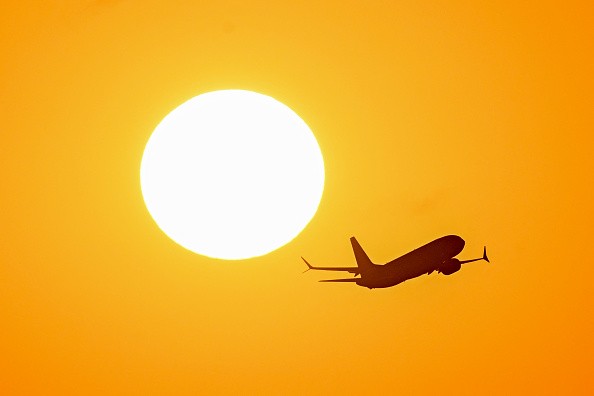According to scientists at the University of Reading in the United Kingdom, atmospheric turbulence is responsible for 71% of in-flight weather-related injuries, and turbulence is only getting worse with global warming.
While winter is traditionally the most turbulent season, modeling indicates that by 2050, summers will be as turbulent as winters were in the 1950s.
The paper, "Clear-air turbulence trends in high-resolution climate models over the North Atlantic," was published in the international journal Climate Dynamics.
A more turbulent future
 (Photo : LUIS ROBAYO/AFP via Getty Images)
(Photo : LUIS ROBAYO/AFP via Getty Images)

One of the more dangerous weather-related hazards is clear-air turbulence (CAT). It typically occurs in cloud-free upper-level atmospheres, with no visual cues for pilots and undetectable by onboard radar; these events appear to occur out of nowhere, as per Phys.org.
Prolonged exposure to turbulence reduces the fatigue life or the amount of time the aircraft can be in service.
More intense clear-air turbulence can damage aircraft fittings and cause severe structural damage. In extreme cases, this could even result in the aircraft breaking up.
Unrestrained cargo, passenger luggage, or passengers themselves can collide during moderate turbulence, causing damage or injury.
In December 1997, a United Airlines Boeing 747, flight UA826, encountered a CAT event en route from Tokyo to Hawaii.
The Boeing moved upward at 1.8 g (g-force), sideways at 0.1 g, and dropped rapidly six seconds later, resulting in a negative g-force of -0.8g.
One passenger died, and several other passengers and crew members were seriously injured. The aircraft was retired one year early.
Because of the presence of the mid-latitude, the eddy-driven jet stream over the North Atlantic, transatlantic air travel frequently encounters CAT. CAT events, according to the researchers, occur in areas of shear-driven instability.
They are frequently found in upper-level jet streams, which are narrow bands of intense winds with a strong seasonal dependence.
A jet stream's intensity is determined by latitudinal horizontal temperature gradients.
With anthropogenic climate change, jet streams are expected to intensify in wind shear due to the steepening of the pole-to-equator temperature gradient in the upper troposphere and lower stratosphere.
In the formation analysis, the researchers used three global climate modeling simulators covering the period 1950-2050: the Hadley Center Global Environment Model in the Global Coupled configuration 3.1, the Max-Plank Institute model MPI-ESM1-2, and EC-Earth-3, a model developed by 27 European research organizations and universities.
The researchers created a robust range of CAT-generated situations by combining these models with 21 turbulent airflow mechanisms.
According to the assessment, for every 1 °C increase in global near-surface warming, moderate CAT events will increase by 14% in summer and autumn and 9% in winter and spring. Moderate turbulence is said to cause vertical accelerations of up to 0.5g.
More flights will encounter CAT events on current flight paths as turbulence increases throughout the year.
Airlines may choose to avoid areas where CAT forms as one option. This could result in longer transatlantic flight times and thousands of extra hours of flight and fuel costs-a good reminder that the seatbelt sign is there for a reason, and wearing yours even when the light is off may be the safest plan in the future.
Also Read: Heatwave Prompted by Climate Change May Cause Shortage of Christmas Tree This Year
climate change can make air travel worse
Planes must travel faster to take off in hotter weather. In extreme heat, planes may not have enough runway to reach the necessary speed to take off, as per Environmental defense Fund.
That heat can cause aircraft to be grounded: in 2017, a 119-degree day forced American Airlines to cancel more than 40 flights out of Phoenix.
Scientists are studying the effects of climate change on jet streams, which are bands of air currents, and they are noticing stronger variations in wind speed, which can cause more severe turbulence.
In a 2017 study, Paul Williams, an atmospheric scientist at the University of Reading in the United Kingdom, calculated that climate change could increase severe turbulence incidents by 149 percent within decades.
Heat stress and other illnesses associated with extreme working conditions can be caused by high temperatures on the tarmac.
During hot weather, concrete and asphalt become "heat islands," or spots that are hotter than the surrounding areas, putting airport workers at risk.
Scientists are confident that continued warming will endanger human health, potentially making outdoor work impossible in many areas.
Airports can become inoperable due to extreme heat or flooding. When temperatures reach 100 degrees Fahrenheit, tarmacs can become soft, causing plane wheels to become stuck.
In addition to extreme heat, human-caused climate change is contributing to rising sea levels, which leads to higher storm surges and more flooding. In fact, the United States experienced five 1,000-year floods between October 2015 and August 2016.
Meanwhile, many airports are located in flat, coastal areas or in floodplains where extreme storms can flood runways.
According to federal statistics, weather accounts for roughly one-third of all flight delays. Delays cost the industry and passengers billions of dollars each year.
One reason passengers face such financial hardship is that airlines regard weather as a "act of God" beyond their control. It is entirely up to them whether to provide refunds or compensation.
Climate change, according to scientists, will likely bring more and more intense storms, potentially leading to more delays and cancellations in the coming years.
Related article: Adapting to Climate Change Could Still Mean Environmental Troubles
© 2024 NatureWorldNews.com All rights reserved. Do not reproduce without permission.

![Tsunami Hazard Zones: New US Map Shows Places at Risk of Flooding and Tsunamis Amid Rising Sea Levels [NOAA]](https://1471793142.rsc.cdn77.org/data/thumbs/full/70325/280/157/50/40/tsunami-hazard-zones-new-us-map-shows-places-at-risk-of-flooding-and-tsunamis-amid-rising-sea-levels-noaa.jpg)



